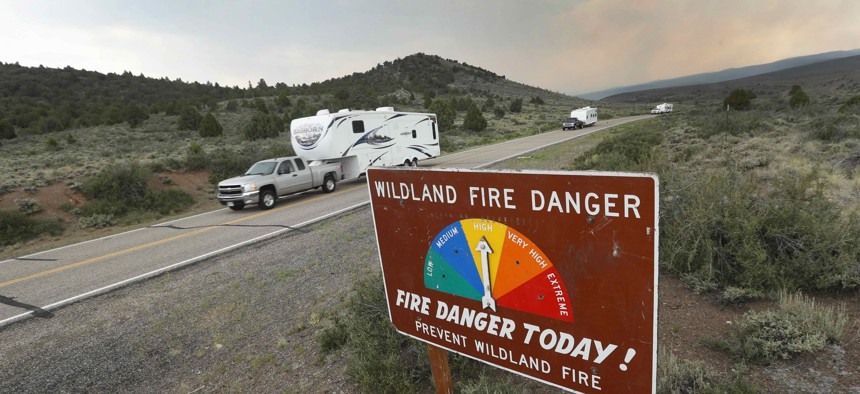A $7.3B Pot of Money to Prepare Infrastructure for Climate Change

People remove travel trailers down highway 143 from their homes that have been evacuated due to a wildfire in Utah in 2017. George Frey/Getty Images
The new federal funding aims to make transportation assets, like roads, transit systems and ports more resilient to flooding, wildfires and other extreme weather and climate threats.
The Biden administration is providing states with more detail about how they can use money from the federal infrastructure law to protect people and structures from the perils of climate change, a move that’s drawing cheers from both political parties.
Transportation Secretary Pete Buttigieg highlighted the new resilience money on a trip to Utah last Friday, where he saw the aftereffects of wildfires in the state and discussed the needs for infrastructure upgrades with Utah’s Republican governor and Democratic mayors from the Salt Lake City area.
The infrastructure law provides states with $7.3 billion over five years for resilience-related transportation projects, although states can opt to use up to half of their share for other uses.
Utah Gov. Spencer Cox joined the transportation secretary at the Utah Capitol. The governor praised the funding as a “bipartisan solution.” (One of the senators who negotiated the package was U.S. Sen. Mitt Romney, a Republican from Utah.)
“This money provides the resources local governments will need to move quickly to address these issues without impacting other needs,” Cox said, according to the Salt Lake Tribune. “Hotter temperatures and drought are a recipe for wildfires. This program will make our infrastructure more resilient.”
The new Promoting Resilient Operations for Transformative, Efficient and Cost-Saving Transportation (PROTECT) program is designed to help states mitigate the transportation-related effects of climate change. That includes planning for disasters, hardening existing structures and improving evacuation routes.
“In general, eligible projects include highway and transit projects, bicycle and pedestrian facilities, and port facilities including those that help improve evacuations or disaster relief,” the Federal Highway Administration explained in a press release. “States are encouraged to work with regional and local partner organizations to prioritize transportation and emergency response improvements, as well as address vulnerabilities.”
The infrastructure package includes both discretionary grants and money that’s automatically given to states based on formulas spelled out in the law. But the details released by the Transportation Department last week only applied to the formula-based grants.
California is set to receive $631 million of the PROTECT formula money over the next five years, the most of any state. Delaware will get the least of any state, with $30 million.
States can use up to 50% of their share of the resilience money to supplement federal transportation programs in other areas, including pollution control, safety improvement or even highway construction.
But states can reduce the share of a project’s costs they bear through the program if they develop resilience improvement plans
The FHWA provided an overview of the formula program here, as well as more detailed guidance here.
Daniel C. Vock is a senior reporter for Route Fifty based in Washington, D.C.
NEXT STORY: Power struggles in Data Center Alley






